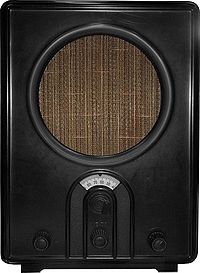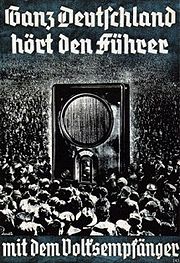
Volksempfänger
Encyclopedia

Radio
Radio is the transmission of signals through free space by modulation of electromagnetic waves with frequencies below those of visible light. Electromagnetic radiation travels by means of oscillating electromagnetic fields that pass through the air and the vacuum of space...
receivers developed by engineer Otto Griessing
Otto Griessing
Otto Griessing was a German electronics engineer. He became known following his design of the so-called Volksempfänger , one of the sets on display at the 10th German Radio Show in August 1933...
at the request of Propaganda Minister Joseph Goebbels
Joseph Goebbels
Paul Joseph Goebbels was a German politician and Reich Minister of Propaganda in Nazi Germany from 1933 to 1945. As one of Adolf Hitler's closest associates and most devout followers, he was known for his zealous oratory and anti-Semitism...
.
The purpose of the Volksempfänger-program was to make radio reception technology affordable to the general public. Joseph Goebbels realized the great propaganda potential of this relatively new medium and thus considered widespread availability of receivers highly important.
History
The original Volksempfänger VE301 model was presented on August 18, 1933 at the Internationale Funkausstellung BerlinInternationale Funkausstellung Berlin
The IFA or Internationale Funkausstellung Berlin is one of the oldest industrial exhibitions in Germany. Between 1924 and 1939 it was an annual event, but as from 1950 it was organized on a two yearly basis until 2005. Since then it has become an annual event again, held in September...
. The VE301 was available at a readily affordable price of 76 German Reichsmark
German reichsmark
The Reichsmark was the currency in Germany from 1924 until June 20, 1948. The Reichsmark was subdivided into 100 Reichspfennig.-History:...
(equivalent to two weeks' average salary), and a cheaper 35 Reichsmark model, the DKE38 (sometimes called Goebbels-Schnauze – "Goebbels' snout" – by the general public) fitted with a multisection tube
Vacuum tube
In electronics, a vacuum tube, electron tube , or thermionic valve , reduced to simply "tube" or "valve" in everyday parlance, is a device that relies on the flow of electric current through a vacuum...
, was also later produced, along with a series of other models under the Volksempfänger, Gemeinschaftsempfänger, KdF (Kraft durch Freude), DKE (Deutscher Kleinempfänger) and other brands.

Deutschlandsender
Deutschlandsender is one of the longest-established radio station names in German. It was used between 1926 and the end of 1993 to denote a number of powerful stations designed to achieve all-Germany coverage .-1926—1945:The first Deutschlandsender, broadcasting from a powerful transmitter...
and regional stations of the Reichs-Rundfunk-Gesellschaft
Reichs-Rundfunk-Gesellschaft
The Reichs-Rundfunk-Gesellschaft , which can be loosely translated as the State Broadcasting Company, was a national network of German regional public broadcasting companies active from 1925 until 1945...
, so as to ensure that Nazi propaganda
Nazi propaganda
Propaganda, the coordinated attempt to influence public opinion through the use of media, was skillfully used by the NSDAP in the years leading up to and during Adolf Hitler's leadership of Germany...
broadcasts could readily be heard while other media, such as the BBC
BBC
The British Broadcasting Corporation is a British public service broadcaster. Its headquarters is at Broadcasting House in the City of Westminster, London. It is the largest broadcaster in the world, with about 23,000 staff...
's European Service (now the World Service), could not. To this end most Volksempfängers lacked shortwave
Shortwave
Shortwave radio refers to the upper MF and all of the HF portion of the radio spectrum, between 1,800–30,000 kHz. Shortwave radio received its name because the wavelengths in this band are shorter than 200 m which marked the original upper limit of the medium frequency band first used...
bands and didn't follow the practice, common at the time among other receiver manufacturers, of marking the approximate dial positions of major European stations on its tuning scale. Generally only German (and later
Anschluss
The Anschluss , also known as the ', was the occupation and annexation of Austria into Nazi Germany in 1938....
Austrian) stations were marked and cheaper models didn't have a proper scale at all (an example pictured above has its dial marked in arbitrary numbers rather than metres
Wavelength
In physics, the wavelength of a sinusoidal wave is the spatial period of the wave—the distance over which the wave's shape repeats.It is usually determined by considering the distance between consecutive corresponding points of the same phase, such as crests, troughs, or zero crossings, and is a...
or kilocycles). The sensitivity was lower than a normal radio although in practice it could with some difficulty still be used to receive foreign stations (including the BBC) particularly as these stations increased their transmission power during the war.
Listening to foreign stations became a criminal offence in Nazi Germany
Nazi Germany
Nazi Germany , also known as the Third Reich , but officially called German Reich from 1933 to 1943 and Greater German Reich from 26 June 1943 onward, is the name commonly used to refer to the state of Germany from 1933 to 1945, when it was a totalitarian dictatorship ruled by...
when the war began, while in some occupied territories, such as Poland
Poland
Poland , officially the Republic of Poland , is a country in Central Europe bordered by Germany to the west; the Czech Republic and Slovakia to the south; Ukraine, Belarus and Lithuania to the east; and the Baltic Sea and Kaliningrad Oblast, a Russian exclave, to the north...
, all radio listening by non-German citizens was outlawed (later during the war this prohibition was extended to most other occupied countries coupled with mass seizures of radio sets). Penalties ranged from confiscation of radios and imprisonment to, particularly later in the war, the death penalty. Nevertheless, such clandestine listening was widespread in many Nazi-occupied countries and (particularly later in the war) in Germany
Germany
Germany , officially the Federal Republic of Germany , is a federal parliamentary republic in Europe. The country consists of 16 states while the capital and largest city is Berlin. Germany covers an area of 357,021 km2 and has a largely temperate seasonal climate...
itself. The Nazis also attempted radio jamming
Radio jamming
Radio jamming is the transmission of radio signals that disrupt communications by decreasing the signal to noise ratio. Unintentional jamming occurs when an operator transmits on a busy frequency without first checking whether it is in use, or without being able to hear stations using the frequency...
of some enemy stations with limited success.
Effects
Much has been said about the efficiency of the Volksempfänger as a propaganda tool. Most famously, Hitler's architect and Minister for Armaments and War Production, Albert SpeerAlbert Speer
Albert Speer, born Berthold Konrad Hermann Albert Speer, was a German architect who was, for a part of World War II, Minister of Armaments and War Production for the Third Reich. Speer was Adolf Hitler's chief architect before assuming ministerial office...
, said in his final speech at the Nuremberg trials
Nuremberg Trials
The Nuremberg Trials were a series of military tribunals, held by the victorious Allied forces of World War II, most notable for the prosecution of prominent members of the political, military, and economic leadership of the defeated Nazi Germany....
:
Utility receiver
The British equivalent of the Volksempfänger was the Utility RadioUtility Radio
The Utility Radio was an all-mains 4-valve domestic superhet radio receiver, manufactured in Great Britain during World War II.When war broke out in 1939 all the British radio manufacturers switched to producing a wide range of military radio equipment for the armed forces. Perhaps the most famous...
which was produced to a standard government approved design by a consortium
Consortium
A consortium is an association of two or more individuals, companies, organizations or governments with the objective of participating in a common activity or pooling their resources for achieving a common goal....
of manufacturers using standard components to make repair easier. However, the primary purpose of the British design was to economise on the use of scarce materials and simplify repairs rather than to frustrate attempts at listening to foreign stations. (Such listening was officially discouraged but not actually forbidden in the United Kingdom
United Kingdom
The United Kingdom of Great Britain and Northern IrelandIn the United Kingdom and Dependencies, other languages have been officially recognised as legitimate autochthonous languages under the European Charter for Regional or Minority Languages...
).
The Volksempfänger in popular culture
- The album Radio-ActivityRadio-ActivityRadio-Activity is the fifth studio album by German electronic band Kraftwerk, released in October 1975. Unlike Kraftwerk's later albums, which featured language-specific lyrics, only the titles differ between the English and German editions...
, released in 1975, by German electronic musicElectronic musicElectronic music is music that employs electronic musical instruments and electronic music technology in its production. In general a distinction can be made between sound produced using electromechanical means and that produced using electronic technology. Examples of electromechanical sound...
pioneers KraftwerkKraftwerkKraftwerk is an influential electronic music band from Düsseldorf, Germany. The group was formed by Ralf Hütter and Florian Schneider in 1970, and was fronted by them until Schneider's departure in 2008...
prominently features a Volksempfänger, of the DKE brand (model 38), on its cover. - German band Welle: Erdball has also produced a song entitled Volksempfänger VE-301, which first appeared on their Die Wunderwelt der Technik album of 2002.
Further reading
|journal=Mitteilungen des Studienkreises Rundfunk und Geschichte |volume=9 |issue= |year=1983 |pages=140–157 }} |publisher=Metropol |location=Berlin |year=2003 |isbn=3936411050 }} |journal=Vierteljahreshefte für Sozial- und Wirtschaftsgeschichte |volume=90 |issue= |year=2003 |pages=269–289 |doi= }} |journal=Technikgeschichte |volume=70 |issue= |year=2003 |pages=73–102 |doi= }} |journal=Vierteljahrshefte für Zeitgeschichte |volume=11 |issue= |year=1963 |pages=418–435 |doi= }} |journal=Zeitschrift für Geschichtswissenschaft |volume=54 |issue= |year=2006 |pages=442–467 |doi= }} |editor1-first=Inge |editor1-last=Marßolek |editor2-first=Adelheid von |editor2-last=Saldern |title=Radiozeiten. Herrschaft, Alltag, Gesellschaft (1924–1960) |publisher=Vlg. f. Berlin-Brandenburg |location=Potsdam |year=1999 |pages=136–159 |isbn=3932981448 }} |location=Essen |publisher=Klartext Vlg. |year=2005 |isbn=3898614921 }}External links
- Comprehensive reference of German made Volksempfängers, with pictures
- Volksempfänger schematics, various models
- Radiomuseum Fürth
- Transdiffusion Radiomusications "Hitlers Radio"
- Volksempfängers, various models, pictures "VE 301, DKE38, DAF 1011"
- Gray and Black Radio Propaganda against Nazi Germany Extensively illustrated paper describes the Volksempfänger in the context of British attempts to penetrate Germany's airwaves.

